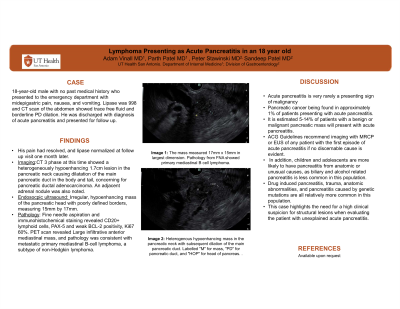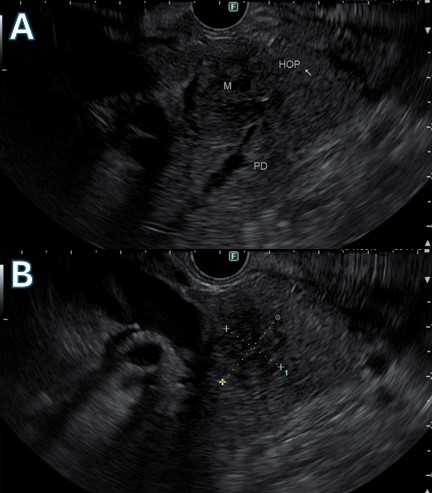Tuesday Poster Session
Category: Biliary/Pancreas
P3532 - Lymphoma Presenting as Acute Pancreatitis in an 18-Year-Old
Tuesday, October 29, 2024
10:30 AM - 4:00 PM ET
Location: Exhibit Hall E

Has Audio
- AV
Adam Vinall, MD
University of Texas Health Science Center
San Antonio, TX
Presenting Author(s)
Adam Vinall, MD1, Parth Patel, MD2, Peter Stawinski, MD1, Sandeep Patel, DO1
1University of Texas Health Science Center, San Antonio, TX; 2University of Texas Health San Antonio, San Antonio, TX
Introduction: Acute pancreatitis is a rare but described initial presentation for cancers of the pancreas and is associated with delay in cancer diagnosis. Here we describe a young adult whose initial presentation for metastatic mediastinal B-cell lymphoma was acute pancreatitis.
Case Description/Methods: The patient is an 18-year-old male with no past medical history who presented to the emergency department with midepigastric pain, nausea, and vomiting. He had recently had wisdom tooth extraction one week prior and was prescribed antibiotics. He had no surgical history or family history of malignancy. His exam was unremarkable except for abdominal tenderness to palpation. Initial laboratory evaluation was significant for lipase of 998 (upper limit of normal = 78), normal complete blood count, and normal liver function tests. Right upper quadrant ultrasound revealed no gallstones or other abnormalities. CT of the abdomen showed trace free fluid in the abdomen and borderline pancreatic ductal dilation. The patient was discharged from the emergency department. His pain had resolved, and lipase normalized at follow up visit one month later. CT 3 phase at this time showed a heterogeneously hypoenhancing 1.7cm lesion in the pancreatic neck causing dilatation of the main pancreatic duct in the body and tail, concerning for pancreatic ductal adenocarcinoma. An adjacent adrenal nodule was also noted. Follow up endoscopic ultrasound (EUS) was performed and revealed an irregular, hypoenhancing mass of the pancreatic head with poorly defined borders, measuring 15mm by 17mm. Fine needle aspiration and immunohistochemical staining revealed CD20+ lymphoid cells, PAX-5 and weak BCL-2 positivity, Ki67 60%. PET scan revealed a large infiltrative anterior mediastinal mass, and pathology was consistent with metastatic primary mediastinal B-cell lymphoma, a subtype of non-Hodgkin lymphoma. He was referred to hematology and started on chemotherapy.
Discussion: Acute pancreatitis is very rarely a presenting sign of malignancy, with pancreatic cancer being found in approximately 1% of patients presenting with acute pancreatitis. It is estimated 5-14% of patients with a benign or malignant pancreatic mass will present with acute pancreatitis. ACG Guidelines recommend imaging evaluation of any patient with the first episode of acute pancreatitis if no discernable cause is evident. This case highlights the need for a high clinical suspicion for structural lesions when evaluating the young patient with acute pancreatitis.

Disclosures:
Adam Vinall, MD1, Parth Patel, MD2, Peter Stawinski, MD1, Sandeep Patel, DO1. P3532 - Lymphoma Presenting as Acute Pancreatitis in an 18-Year-Old, ACG 2024 Annual Scientific Meeting Abstracts. Philadelphia, PA: American College of Gastroenterology.
1University of Texas Health Science Center, San Antonio, TX; 2University of Texas Health San Antonio, San Antonio, TX
Introduction: Acute pancreatitis is a rare but described initial presentation for cancers of the pancreas and is associated with delay in cancer diagnosis. Here we describe a young adult whose initial presentation for metastatic mediastinal B-cell lymphoma was acute pancreatitis.
Case Description/Methods: The patient is an 18-year-old male with no past medical history who presented to the emergency department with midepigastric pain, nausea, and vomiting. He had recently had wisdom tooth extraction one week prior and was prescribed antibiotics. He had no surgical history or family history of malignancy. His exam was unremarkable except for abdominal tenderness to palpation. Initial laboratory evaluation was significant for lipase of 998 (upper limit of normal = 78), normal complete blood count, and normal liver function tests. Right upper quadrant ultrasound revealed no gallstones or other abnormalities. CT of the abdomen showed trace free fluid in the abdomen and borderline pancreatic ductal dilation. The patient was discharged from the emergency department. His pain had resolved, and lipase normalized at follow up visit one month later. CT 3 phase at this time showed a heterogeneously hypoenhancing 1.7cm lesion in the pancreatic neck causing dilatation of the main pancreatic duct in the body and tail, concerning for pancreatic ductal adenocarcinoma. An adjacent adrenal nodule was also noted. Follow up endoscopic ultrasound (EUS) was performed and revealed an irregular, hypoenhancing mass of the pancreatic head with poorly defined borders, measuring 15mm by 17mm. Fine needle aspiration and immunohistochemical staining revealed CD20+ lymphoid cells, PAX-5 and weak BCL-2 positivity, Ki67 60%. PET scan revealed a large infiltrative anterior mediastinal mass, and pathology was consistent with metastatic primary mediastinal B-cell lymphoma, a subtype of non-Hodgkin lymphoma. He was referred to hematology and started on chemotherapy.
Discussion: Acute pancreatitis is very rarely a presenting sign of malignancy, with pancreatic cancer being found in approximately 1% of patients presenting with acute pancreatitis. It is estimated 5-14% of patients with a benign or malignant pancreatic mass will present with acute pancreatitis. ACG Guidelines recommend imaging evaluation of any patient with the first episode of acute pancreatitis if no discernable cause is evident. This case highlights the need for a high clinical suspicion for structural lesions when evaluating the young patient with acute pancreatitis.

Figure: Image A. Heterogenous hypoenhancing mass in the pancreatic neck with subsequent dilation of the main pancreatic duct. Labelled "M" for mass, "PD" for pancreatic duct, and "HOP" for head of pancreas.
Image B. The mass measured 17mm x 15mm in largest dimension. Pathology from FNA showed primary mediastinal B cell lymphoma.
Image B. The mass measured 17mm x 15mm in largest dimension. Pathology from FNA showed primary mediastinal B cell lymphoma.
Disclosures:
Adam Vinall indicated no relevant financial relationships.
Parth Patel indicated no relevant financial relationships.
Peter Stawinski indicated no relevant financial relationships.
Sandeep Patel indicated no relevant financial relationships.
Adam Vinall, MD1, Parth Patel, MD2, Peter Stawinski, MD1, Sandeep Patel, DO1. P3532 - Lymphoma Presenting as Acute Pancreatitis in an 18-Year-Old, ACG 2024 Annual Scientific Meeting Abstracts. Philadelphia, PA: American College of Gastroenterology.
